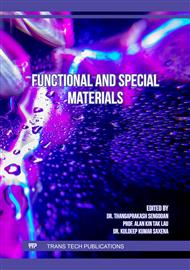[1]
Liu J, Chen X, Liang D, Xie Q. Development of pitch-based carbon fibers: a review. Energy Sources, Part A: Recovery, Utilization and Environmental Effects 2020.
DOI: 10.1080/15567036.2020.1806952
Google Scholar
[2]
Yu Z, Li R, Peng Z, Tang Y. Carbon Fiber Reinforced Epoxy Resin Matrix Composites. Materials Science: Advanced Composite Materials 2017;1:1–6.
Google Scholar
[3]
Solomon B, George D, Shunmugesh K, Akhil KT. The effect of fibers loading on the mechanical properties of carbon epoxy composite. Pol and Pol Compos 2017;25:237–40.
DOI: 10.1177/096739111702500310
Google Scholar
[4]
Vedernikov A, Safonov A, Tucci F, Carlone P, Akhatov I. Pultruded materials and structures: A review. J Compos Mater 2020;54:4081–117.
DOI: 10.1177/0021998320922894
Google Scholar
[5]
Joshi SC. The pultrusion process for polymer matrix composites. Manufacturing Techniques for Polymer Matrix Composites (PMCs), Elsevier; 2012, p.381–413.
DOI: 10.1533/9780857096258.3.381
Google Scholar
[6]
Hadigheh SA, Kashi S. Effectiveness of vacuum consolidation in bonding fibre reinforced polymer (FRP) composites onto concrete surfaces. Constr Build Mater 2018;187:854–64.
DOI: 10.1016/j.conbuildmat.2018.07.200
Google Scholar
[7]
Kunrath K, Kerche EF, Rezende MC, Amico SC. Mechanical, electrical, and electromagnetic properties of hybrid graphene/glass fiber/epoxy composite. Poly and Pol Compos 2019;27:262–7.
DOI: 10.1177/0967391119828559
Google Scholar
[8]
Mallick PK. Fibre-reinforced composites materials, manufacturing and design. 3rd ed. New York: CRC Press; 2007.
DOI: 10.1016/0010-4361(89)90651-4
Google Scholar
[9]
Kerche EF, Trindade RS, Ribeiro AC, Souza JA, Amico SC. Experimental evaluation of temperature effect on the transverse permeability of a fibrous preform. Mater Today Proc 2019;8:731–7.
DOI: 10.1016/j.matpr.2019.02.014
Google Scholar
[10]
Gajjar T, Shah DB, Joshi SJ, Patel KM. Experimental investigations on process parameters for manufacturing of antenna reflectors using vacuum infusion process. SPE Polymers 2021;2:19–27.
DOI: 10.1002/pls2.10026
Google Scholar
[11]
Li W, Krehl J, Gillespie JW, Heider D, Endrulat M, Hochrein K, et al. Process and performance evaluation of the vacuum-assisted process. J Compos Mater 2004;38:1803–14.
DOI: 10.1177/0021998304044769
Google Scholar
[12]
Rana S, Fangueiro R. Advanced Composite Materials for Aerospace Engineering Processing, Properties and Applications. vol. 1. 2016.
Google Scholar
[13]
Khan LA, Mehmood AH. Cost-Effective Composites Manufacturing Processes for Automotive Applications. Lightweight Composite Structures in Transport: Design, Manufacturing, Analysis and Performance, Elsevier Inc.; 2016, p.93–119.
DOI: 10.1016/B978-1-78242-325-6.00005-0
Google Scholar
[14]
Chen X, Tang J, Yang K. Modeling multiple failures of composite box beams used in wind turbine blades. Compos Struct 2019;217:130–42.
DOI: 10.1016/j.compstruct.2019.03.018
Google Scholar
[15]
Salifu S, Desai D, Ogunbiyi O, Sadiku R, Adesina O, Adesina O. Comparative study of high velocity impact response of aluminium 3105-H18 and carbon fibre-epoxy composite double hat bumper beams. Mater Today Proc 2021;38:712–6.
DOI: 10.1016/j.matpr.2020.03.828
Google Scholar
[16]
Klasztorny M, Zajac KP, Nycz DB. GFRP composite footbridge series with multi-box cross section – Part 1: Design methodology, conceptual design and global detailed design. Compos Struct 2020;238:111965.
DOI: 10.1016/j.compstruct.2020.111965
Google Scholar
[17]
Tsai SW, Wu EM. A General Theory of Strength for Anisotropic Materials. J Compos Mater 1971;5:58–80.
DOI: 10.1177/002199837100500106
Google Scholar
[18]
Smith M. ABAQUS/Standard User's Manual, Version 6.9 2009. https://www.research.manchester.ac.uk/portal/en/publications/abaqusstandard-users-manual-version-69(0b112d0e-5eba-4b7f-9768-cfe1d818872e).html (accessed April 28, 2021).
Google Scholar
[19]
de Menezes EAW, Eggers F, Marczak RJ, Iturrioz I, Amico SC. Hybrid composites: Experimental, numerical and analytical assessment aided by online software. Mechanics of Materials 2020;148:103533.
DOI: 10.1016/j.mechmat.2020.103533
Google Scholar
[20]
Chamis CC. Mechanics of Composite Materials: Past, Present, and Future. Journal of Composites, Technology and Research 1989;11:3–14.
Google Scholar
[21]
Kerche EF, da Silva VD, Fonseca E, Salles NA, Schrekker HS, Amico SC. Epoxy-based composites reinforced with imidazolium ionic liquid-treated aramid pulp. Polymer (Guildf) 2021; 226: 123787.
DOI: 10.1016/j.polymer.2021.123787
Google Scholar
[22]
Alves FC, Monticeli FM, Neves RM, Voorwald HJC, Cioffi MOH, Ornaghi HL. Influence of void content and morphology on the creep behavior on glass/epoxy composites. Composites Communications 2021;25:100712.
DOI: 10.1016/j.coco.2021.100712
Google Scholar
[23]
Antin K-N, Machado MA, Santos TG, Vilaça P. Evaluation of Different Non-destructive Testing Methods to Detect Imperfections in Unidirectional Carbon Fiber Composite Ropes. J Nondestr Eval 2019;38:23.
DOI: 10.1007/s10921-019-0564-y
Google Scholar
[24]
Júnior JHSA, Júnior HLO, Amico SC, Amado FDR. Study of hybrid intralaminate curaua/glass composites. Mater Des 2012;42:111–7.
DOI: 10.1016/j.matdes.2012.05.044
Google Scholar
[25]
Ornaghi HL, Bolner AS, Fiorio R, Zattera AJ, Amico SC. Mechanical and Dynamic Mechanical Analysis of Hybrid Composites Molded by Resin Transfer Molding. J Appl Polym Sci 2010; 118: 887–896.
DOI: 10.1002/app.32388
Google Scholar


